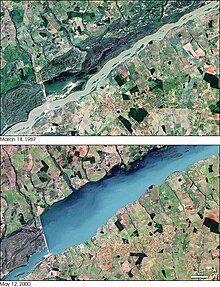Eng Sérgio Motta Dam
| Engineer Sérgio Motta (Porto Primavera) Dam | |
|---|---|
 NASA image of dam before (1987) and after (2000) completion. | |
| Official name | Sérgio Motta Hydroelectric Power Plant |
| Location | Rosana, São Paulo, Brazil |
| Coordinates | 22°28′31″S 52°57′30″W / 22.47528°S 52.95833°W |
| Construction began | 1980 |
| Opening date | 1999 |
| Construction cost | $9 billion USD |
| Owner(s) | CESP |
| Dam and spillways | |
| Type of dam | Embankment, concrete portion |
| Impounds | Paraná River |
| Height | 22 m (72 ft) |
| Length | 11,380 m (37,340 ft) |
| Spillway type | Service, gate-controlled |
| Reservoir | |
| Creates | Sérgio Motta Reservoir |
| Total capacity | 19.9 km3 (16,100,000 acre⋅ft)[1] |
| Surface area | 2,250 km2 (870 sq mi) |
| Power Station | |
| Commission date | 1999–2003 |
| Type | Conventional |
| Turbines | 14 x 110 MW (150,000 hp) Kaplan turbines |
| Installed capacity | 1,540 MW (2,070,000 hp) |
| Annual generation | 10.5 TWh (38 PJ)[2] |
The Engineer Sérgio Motta Dam, formerly known as the Porto Primavera Dam, is an embankment dam on the Paraná River near Rosana in São Paulo, Brazil. It was constructed between 1980 and 1999 for hydroelectric power production, flood control and navigation. An estimated 11 million tropical trees were submerged.
Technical[edit]
The dam is named for Sergio Roberto Vieira da Motta, a prominent industrial engineer in São Paulo. At 11.38 kilometres (7.07 mi) in length, it is the longest dam in Brazil.[3][4]
The 22 metres (72 ft) tall dam creates a reservoir with a 19.9 cubic kilometres (16,100,000 acre⋅ft) capacity and surface area of 2,250 square kilometres (870 sq mi). The dam supports hydroelectric power plant on its southern end with an installed capacity of 1,540 megawatts (2,070,000 hp). The power plant contains 14 x 110 megawatts (150,000 hp) Kaplan turbine generators. Although there are no plans to install them, the power plant has room to accommodate an additional four generators.[4] The dam also supports a 210-metre (690 ft) long and 17-metre (56 ft) wide navigation lock on its southern end with the ability to transport 27 million tons a year.[5]
History[edit]
Construction on the dam began in 1980 and the first filling of the reservoir to 253 metres (830 ft) above sea level was complete by 1998. It was inaugurated in 1999 with the first three generators commissioned in March. In 2000, five more generators came online and by 2001, a total of ten were in operation. The second filling to 257 metres (843 ft) above sea level was complete in March 2001 and by October 2003, all 14 generators were in operation.[6][7]
The dam flooded 13,227 hectares (32,680 acres) of the Lagoa São Paulo Reserve and 3,211 hectares (7,930 acres) of the Great Pontal Reserve.[8] In compensation, the Companhia Energética de São Paulo (CESP) created the 73,345 hectares (181,240 acres) Rio Ivinhema State Park, the 7,720 hectares (19,100 acres) Rio do Peixe State Park, the 9,043 hectares (22,350 acres) Aguapeí State Park and the 6,262 hectares (15,470 acres) Cisalpina Private Natural Heritage Reserve.[9]
In 2005, an infestation of Hydrilla verticillata was discovered in the reservoir, the first time the invasive weed was discovered in Brazil. The dam has also had negative effects on downstream fish reproduction[10] and has a 520-metre (1,710 ft) long fish ladder.[11]
See also[edit]
- List of power stations in Brazil
- Fishermen Tales: Memories of drouned lives (UNESP, Master thesis)
- Fishermen's histories: a study with riparians ousted by a hydroelectric power station (Article published in: Revista Psicologia Política)
- Space and Subjectivity: study with riparian people (Article published in: Psicologia & Sociedade, v.23)
- Impacts of the construction of hydroelectric power stations in the life of the riparian population (Article published in: Emancipação, v.9)
References[edit]
- ^ Pompêo, Marcelo (2004). "Major Brazilian Dams". Ciudad Universitaria, São Paulo. Archived from the original on 19 August 2014. Retrieved 13 September 2010.
- ^ "RELATÓRIO ANUAL DA ADMINISTRAÇÃO - 2011" (PDF). Energética de São Paulo, CNPJ 60.933.603/0001-78 - Companhia Aberta (in Portuguese). CESP - Companhia Energética de São Paulo.
- ^ "CESP complete 1,000 days without accidents in Porto Primavera". CESP. Archived from the original on 21 August 2010. Retrieved 13 September 2010.
- ^ a b "Hydroelectric Plants in Brazil - São Paulo". IndustCards. Archived from the original on 8 December 2012. Retrieved 13 September 2010.
- ^ "Hydropower Completed" (PDF). SAO PAULO STATE UNIVERSITY. Retrieved 13 September 2010.
- ^ "Porto Primavera Hydroelectric Plant". CESP. Archived from the original on 28 September 2009. Retrieved 13 September 2010.
- ^ "CESP - Pre Privatisation". CESP. Archived from the original on 12 March 2012. Retrieved 13 September 2010.
- ^ PES do Rio do Peixe – ISA, Historico Juridico.
- ^ Unidades de Conservação – CSEP.
- ^ "Porto Primavera Reservoir, Brazil". NASA. Retrieved 13 September 2010.
- ^ Makrakis, Sérgio (2007). "Utilization of the fish ladder at the Engenheiro Sergio Motta Dam, Brazil, by long distance migrating potamodromous species" (PDF). Sociedade Brasileira de Ictiologia. Retrieved 13 September 2010.
Sources[edit]
- PES do Rio do Peixe (in Portuguese), ISA: Instituto Socioambiental, retrieved 2016-11-12
- Unidades de Conservação (in Portuguese), CESP: Companhia Energética de São Paulo, archived from the original on 2014-05-02, retrieved 2016-11-13
- Dams completed in 1999
- Energy infrastructure completed in 1999
- Energy infrastructure completed in 2000
- Energy infrastructure completed in 2001
- Dams in São Paulo (state)
- Hydroelectric power stations in Brazil
- Embankment dams
- Dams on the Paraná River
- Locks of Brazil
- 1999 establishments in Brazil
- Dams with fish ladders

